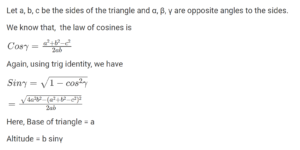Area of a Triangle from Sides
You can calculate the area of a triangle if you know the lengths of all three sides, using a formula that has been known for nearly 2000 years.
It is called “Heron’s Formula” after Hero of Alexandria
Just use this two step process:
Step 1: Calculate “s” (half of the triangles perimeter):
s = (a+b+c) / 2
Step 2: Then calculate the Area:
![]()
Semi perimeter, s = Perimeter of triangle/2 = (a+b+c)/2
And a, b, c are the three sides of the triangle.

Proof of Heron’s Formula
There are two methods by which we can derive Heron’s formula.
- First, by using trigonometric identities and cosine rule.
- Secondly, solving algebraic expressions using the Pythagoras theorem.
Let us see one by one both the proofs or derivation.
Using Cosine Rule
Let us prove the result using the law of cosines:

Now,

Note: Heron’s formula is applicable to all types of triangles and the formula can also be derived using the law of cosines and the law of Cotangents.
How to Find the Area Using Heron’s Formula?
To find the area of a triangle using Heron’s formula, we have to follow two steps:
- Find the perimeter of the given triangle
- Then, find the value of the semi-perimeter of the given triangle; S = (a+b+c)/2
- Now use Heron’s formula to find the area of a triangle (√(s(s – a)(s – b)(s – c)))
- Finally, represent the area with the accurate square units (such as m2, cm2, in2, etc.)
Applications of Heron’s Formula
The two major applications of Heron’s formula are:
- To find the area of different types of a triangle (when the length of three sides are given)
- To find the area of a quadrilateral (when the length of all three sides are given)
